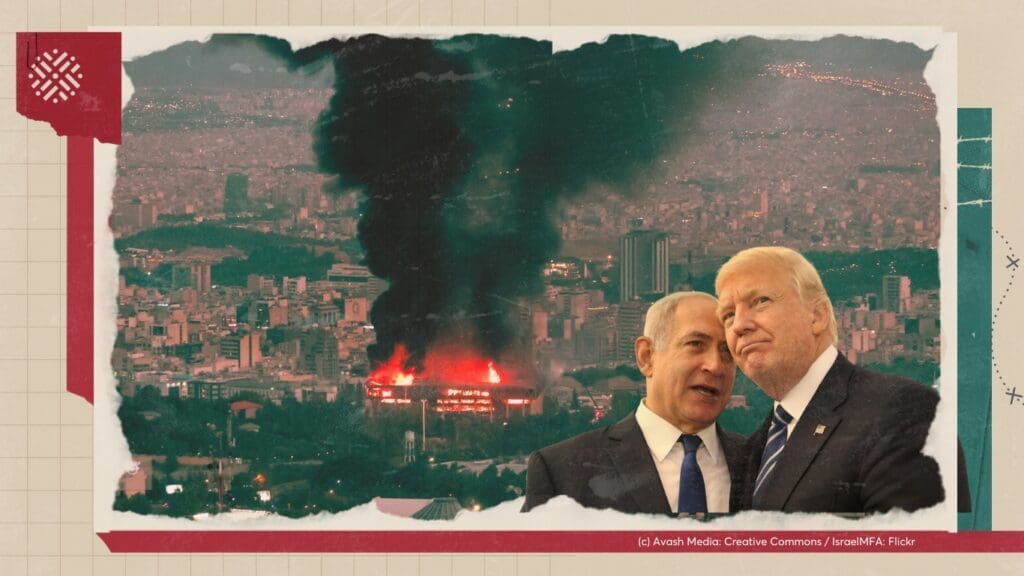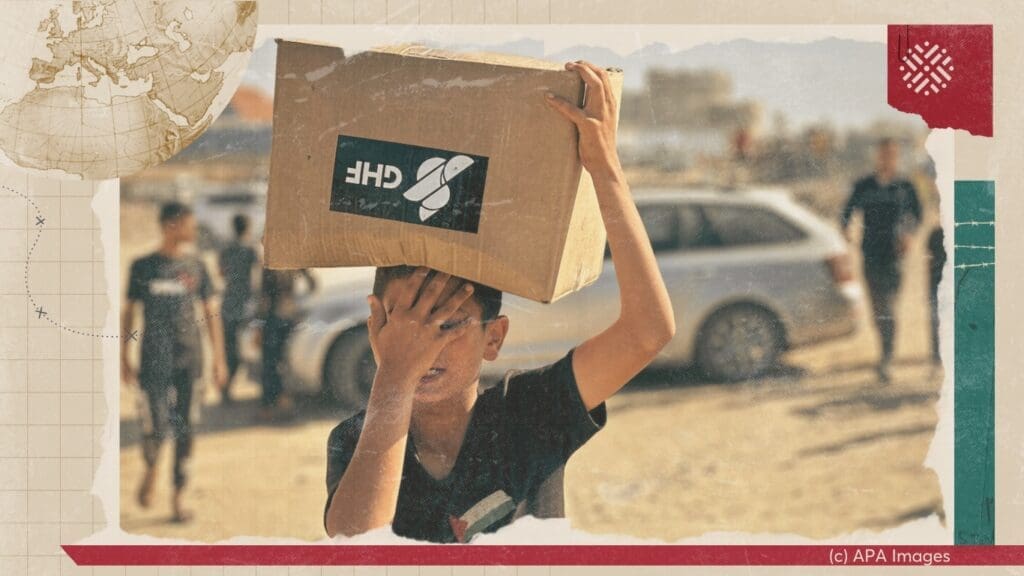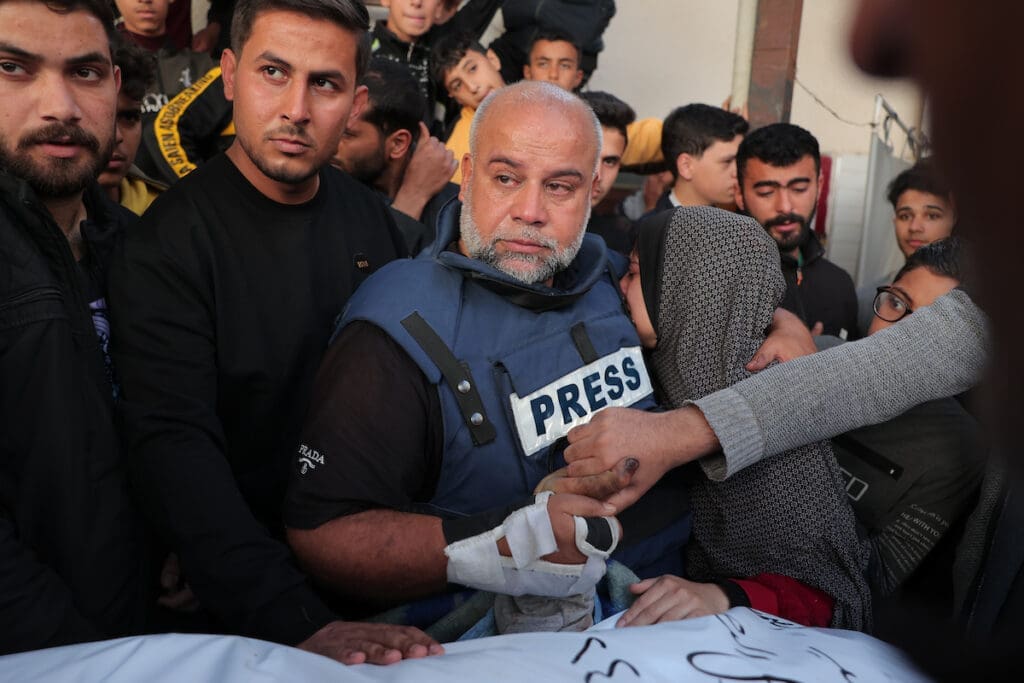- Topics
-
Topics
See our analysis on civil society and how it shapes culture, politics, and policies
Read our insights on the shifting political landscape and what it means for Palestine
Learn more about the policies and practices shaping the Palestinian economy
Strengthen your understanding of the unique conditions for Palestinian refugees across the Middle East
-
- Analysis
-
Analysis
In-depth analysis on existing or potential policies that impact possibilities for Palestinian liberation.
Insights and perspectives on social, political, and economic questions related to Palestine and Palestinians globally.
Concise analysis into a specific policy, its background and implications.
Commentary that brings together insights from multiple analysts.
Compilations of past Al-Shabaka works surrounding a specific theme.
Longer-form, ad hoc projects that seek to confront research questions outside the scope of our regular analysis.
A policy-driven research initiative by Al-Shabaka: The Palestinian Policy Network.
Our monthly webinar series that brings together Palestinian experts.
Featured
On Thursday, June 19, 2025, Israeli Prime Minister Benjamin Netanyahu stood in front of the aftermath of an Iranian strike near Bir al-Saba’ and told journalists: “It really reminds me of the British people during the Blitz. We are going through a Blitz.” The Blitz refers to the sustained bombing campaign carried out by Nazi Germany against the UK, particularly London, between September 1940 and May 1941. With this dramatic comparison, Netanyahu sought to elicit Western sympathy and secure unconditional support for his government’s latest act of military escalation and violation of international law: the unprovoked bombing of Iran. This rhetorical move is far from new; it has become an enduring trope in Israeli political discourse—one that casts Israel as the perennial victim and frames its opponents as modern-day Nazis. Netanyahu has long harbored ambitions of striking Iran with direct US support, but timing has always been central. This moment, then, should not be viewed merely as opportunistic aggression, but as part of a broader, calculated strategy. His actions are shaped by a convergence of unprecedented impunity, shifting regional dynamics, and deepening domestic political fragility. This commentary examines the latest escalation in that context and discusses the broader political forces driving it. Yara Hawari· Jun 26, 2025Launched on May 26, 2025, and secured by US private contractors, the new Israeli-backed aid distribution system in Gaza has resulted in over 100 Palestinian deaths, as civilians navigated dangerous conditions at hubs positioned near military outposts along the Rafah border. These fatalities raise grave concerns about the safety of the aid model and the role of US contractors operating under Israeli oversight. This policy memo argues that the privatization of aid and security in Gaza violates humanitarian norms by turning aid into a tool of control, ethnic cleansing, and colonization. It threatens Palestinian life by conditioning life-saving aid, facilitating forced displacement, and shielding the Israeli regime from legal and moral responsibility. It additionally erodes local and international institutions, especially UNRWA, which has been working in Gaza for decades.
Yara Hawari· Jun 26, 2025Launched on May 26, 2025, and secured by US private contractors, the new Israeli-backed aid distribution system in Gaza has resulted in over 100 Palestinian deaths, as civilians navigated dangerous conditions at hubs positioned near military outposts along the Rafah border. These fatalities raise grave concerns about the safety of the aid model and the role of US contractors operating under Israeli oversight. This policy memo argues that the privatization of aid and security in Gaza violates humanitarian norms by turning aid into a tool of control, ethnic cleansing, and colonization. It threatens Palestinian life by conditioning life-saving aid, facilitating forced displacement, and shielding the Israeli regime from legal and moral responsibility. It additionally erodes local and international institutions, especially UNRWA, which has been working in Gaza for decades. Safa Joudeh· Jun 10, 2025In this policy lab, Mariam Barghouti and Sharif Abdel Kouddous join host Tariq Kenney-Shawa to discuss Israel’s targeted assassination campaign against Palestinian journalists, the complicity of Western media in normalizing these crimes, and how this silence allows Israel to get away with genocide.
Safa Joudeh· Jun 10, 2025In this policy lab, Mariam Barghouti and Sharif Abdel Kouddous join host Tariq Kenney-Shawa to discuss Israel’s targeted assassination campaign against Palestinian journalists, the complicity of Western media in normalizing these crimes, and how this silence allows Israel to get away with genocide. Mariam Barghouti· May 28, 2025
Mariam Barghouti· May 28, 2025
-
- Resources
- Media & Outreach
- The Network




Tracking the Trends of the Palestinian Cause Since 1967
The Palestinian cause today has in some respects reverted to where it stood before the 1967 War. It is worth retracing this trajectory to understand how we reached the current situation, and derive insights on where to go from here.1
Looking Back
On the eve of June 5, 1967, the Palestinians were dispersed among Israel, the Jordanian-ruled West Bank (including East Jerusalem), the Gaza Strip administered by Egypt, and refugee communities in Jordan, Syria, Lebanon, and beyond. Their aspirations for salvation and self-determination were pinned to Arab leaders’ pledges to “liberate Palestine” – which then referred to those parts of Mandate Palestine that became Israel in 1948 – and in particular to the charismatic Egyptian leader Gamal Abdel-Nasser.
The Six-Day War, which resulted in Israel’s occupation of the Palestinian West Bank, East Jerusalem, the Gaza Strip, the Syrian Golan Heights, and the Egyptian Sinai Peninsula, brought dramatic changes to the geography of the conflict. It also produced a sea change in the Palestinian body politic. In a sharp break with previous decades, Palestinians became the masters of their own destiny rather than spectators to regional and international decisions affecting their lives and determining their fate.
The Palestine Liberation Organization (PLO), which had been established in 1964 under the aegis of the Arab League at its first summit meeting, was overtaken in 1968-69 by the Palestinian guerrilla groups that had been forming underground since the 1950s, with Fatah (the Palestinian National Liberation Movement) at their head. The Arab defeat in 1967 created a vacuum in which Palestinians were able to re-establish custodianship over the question of Palestine, transform the dispersed parts of the Palestinian population into a unified people and political actor, and place the Palestinian cause at the heart of the Arab-Israeli conflict.
This, perhaps the PLO’s most important achievement, has sustained the spirit of the Palestinian quest for self-determination despite the myriad wounds inflicted by Israel and some Arab states – and despite the self-inflicted wounds. The setbacks the PLO suffered were many, even as it succeeded in putting the Palestinian question high on the international agenda. It is worth reviewing the PLO’s successes and defeats in order to understand how the Palestinian national movement reached the place it is in today.
The PLO proved incapable of capitalizing on the success of the First Intifada Share on XThe first PLO victory also laid the seeds of a defeat. The 1968 battle of Karameh in the Jordan Valley, in which the guerrillas and the Jordanian Army pushed back a far superior Israeli expeditionary force, gained many Palestinian and Arab adherents to the movement, whether refugees, guerrillas, or businessmen from across the political spectrum. At the same time, the implicit threat to the Hashemite monarchy was clear, and Palestinian relations with Jordan worsened until the PLO was expelled from Jordan during Black September in 1970. This effectively meant that the PLO no longer had a credible military option against Israel, assuming it ever had. Although the Palestinians would maintain an extensive military presence in Lebanon until 1982, it was a poor substitute for the longest Arab frontier with historic Palestine.
During the 1973 October War, Egypt and Syria achieved partial victories against Israel but also suffered severe setbacks, demonstrating that the Arab states also had only limited military options against Israel. At the same time, the Palestinian national movement reached its international peak with the late Palestinian leader Yasser Arafat’s speech to the UN General Assembly in 1974, with the PLO by now recognized as the sole legitimate representative of the Palestinian people. That year the PLO also began laying the groundwork for a two-state settlement when its parliament, the Palestine National Council, adopted a 10-point plan to establish a “national authority” on any part of Palestine that was liberated.
The process was of necessity painfully slow as it brought the majority of Palestinians to the recognition that an eventual Palestinian state would no longer be established on the totality of the former British Mandate. As of 1974 the acceptance of the reality of Israel as a state and the establishment of a Palestinian state on the West Bank, including East Jerusalem, and the Gaza Strip was to gradually become the goal of the Palestinian national movement.
The late Egyptian President Anwar Sadat’s visit to Jerusalem in 1977, which culminated in the 1979 Camp David Accords and Israel’s withdrawal from the Sinai Peninsula, completed in April 1982, set the stage for Israel’s invasion of Lebanon that same year. Israel’s main goal was to drive the PLO out of the country and consolidate permanent occupation of the Occupied Palestinian Territory (OPT). With the most powerful Arab state removed from the conflict, the ability of the PLO to achieve a two-state settlement was severely circumscribed, and the Arab-Israeli conflict gradually metamorphosed into an Israeli-Palestinian one vastly more advantageous to Israel.
The 1967 War transformed Israel from a regional state into a regional power Share on XAs the PLO tried to regroup in Tunisia and other Arab countries, one of the biggest challenges to Israel emerged within the OPT with the eruption of the First Intifada in December 1987, largely led by a home-grown leadership. This resurrected the option of successfully confronting Israel on the basis of nonviolent mass mobilization on a scale not seen since the late 1930s.
Nevertheless, the PLO proved incapable of capitalizing on the local and global success of the First Intifada. Ultimately, the exiled PLO leadership placed its own interests, chiefly its ambition for Western and particularly American endorsement, above the national rights of the Palestinian people as expressed in the 1988 Declaration of Independence adopted in Algiers.
These contradictions became unambiguous in 1992-93, when the Palestinian leadership had to make a choice between supporting the negotiating position of the Palestinian delegation in Washington, which insisted on a comprehensive moratorium on Israeli settlement activity as a precondition for transitional self-government arrangements, and covert negotiations with Israel that gave it much less but restored it to international relevance in the wake of the 1990-91 Kuwait conflict. Pursuant to the 1993 Oslo Accords, the PLO recognized Israel and its “right to exist in peace and security” in the context of a document that failed to mention occupation, self-determination, statehood, or the right of return. Unsurprisingly the decades since have seen an exponential acceleration of Israeli settler-colonialism and the effective destruction of the autonomy arrangements specified in various Israeli-Palestinian agreements.
Looking Forward
In some respects the situation today has come full circle since 1967. The broadly unified Palestinian national movement that predominated from the 1960s to the 1990s has disintegrated, perhaps terminally so. It is today split between Fatah and Hamas, with the latter, along with Islamic Jihad, as yet excluded from the PLO, while splits within Fatah and the PLO are rife. The Palestinians in Gaza are suffering horrendously under a decade of Israeli blockade that is getting worse on account of PA and Israeli pressure on Hamas. The Palestinians in refugee camps in Syria and Lebanon are suffering greatly from the civil strife in Syria and the earlier fragmentation of Iraq, as well as from conflicts between different groups in the camps.
As for Israel, 1967 transformed it from a regional state into a regional power. It is eager to normalize relations with Saudi Arabia and the Arab Gulf states, using Iran as the bogeyman to nurture that relationship. In turn, it wants to use that alliance to impose a deal on the Palestinians that would effectively perpetuate Israeli domination, achieving a final peace treaty whereby it would keep security control throughout the OPT, maintain its settlements, and continue to colonize.
Israel is pushing back against BDS by conflating criticism of Israel with anti-Semitism Share on XBut there continue to be obstacles in Israel’s path to legitimizing the occupation, which keep the door open for a Palestinian movement and strategy to secure rights and justice. It is no small feat that, during a period comprising half a century, not one state has formally endorsed Israel’s occupation of Palestinian – or Syrian – territory. While European governments, for example, feared that doing so would endanger their relationships with others in region, they are also among the most committed to upholding a rules-based international order; the memories of the First and Second World Wars have not been forgotten. They thus cannot recognize Israel’s occupation even though they have failed to challenge Israel in the same way they have confronted the Russian occupation of Crimea.
Moreover, the election of Donald Trump as US president soon after the United Kingdom voted to leave the European Union last year is hastening the European Union’s determination to consolidate its economic and political power and reduce its dependence on the US for protection. This offers an opportunity for the Palestinians to bolster modest EU measures such as prohibiting research funding to Israeli settlement enterprises and labeling settlement products, and to push for differentiation between Israel and its colonial enterprise, drawing on the language of UN Security Council Resolution 2334 of December 2016.
Israel is also facing resistance in unexpected places. As the Palestinian national movement has weakened, the global Palestine solidarity movement, including the Palestinian-led Boycott, Divestment, and Sanctions Movement (BDS) launched in 2005, has grown rapidly, particularly in the wake of Israel’s repeated assaults on the Gaza Strip. This is in contrast to the situation in the 1970s and 80s, when Western publics tended to be broadly supportive of Israel. Israel is ferociously pushing back against this movement by conflating criticism of Israel with anti-Semitism, and by pushing legislation in the US and Europe to ban boycott initiatives. As yet, however, it has not succeeded in shutting down the debate or in preventing churches and student groups across the US from supporting activities in solidarity with the Palestinian people.
Israel’s pushback is also weakened as a result of a third trend that is entirely of its own making. The fact that it has been able to violate international law unchallenged in its occupation of the Palestinian territories, as well as with its own Palestinian citizens, is leading to overreach. Even Trump’s determination to “do a deal” that would certainly give Israel vast tracts of Palestinian land and permanent security control is likely to hit up against the increasingly powerful right-wing movement, which rejects on principle any concession to the Palestinians.
Indeed, the growing raft of what can only be described as racist laws is exposing not just its present acts but also those of the pre- and early post-1948 era. For example, to name just a few, the citizenship and family law, renewed annually since 2003, denies Palestinian citizens of Israel the right to marry Palestinians from the OPT as well as several other countries; the continued destruction of Palestinian villages within Israel as well as the West Bank; and the law to retroactively legalize the theft of private Palestinian land in the West Bank. All this makes it impossible to pretend that Israel subscribes to either universal or “Western” values, such as the rule of law and equality.
It is impossible to pretend that Israel subscribes to either universal or “Western” values Share on XA good indicator of the impact of this exposure is the fast-growing number of non-Israeli Jews that are becoming increasingly estranged from Israel, including such organizations as Jewish Voice for Peace. When they speak up, pro forma accusations of anti-Semitism are easily deflected, and they empower others to take similar positions.
Another area where Israel has overreached has been in making support for it a partisan issue. As the Republican Party ensures there is no daylight between itself and Israel, opinion in the Democratic Party’s rank-and-file shifts steadily in support of Palestinian rights, and Democratic representatives are slowly becoming emboldened to speak up.
These longer-term trends that work against Israel’s violations of international norms cannot by themselves secure Palestinian rights. The shift from Arab custodianship over the question of Palestine to Palestinian custodianship ultimately resulted in the disaster of Oslo. What is needed is a formula to combine Palestinian mobilization at home and abroad with an Arab strategy to achieve self-determination. And, although efforts to reform the PLO into an effective national representative have failed to date, there are ways to apply pressure on parts of the PLO that still function – for example, in countries where some segments of Palestinian diplomatic representation are still effective – with a view to reviving the national agenda and strategy.
The Palestinians today are without doubt in the most unenviable position they have experienced since 1948. Yet if they mobilize the resources at their disposal – first and foremost their own people and the growing reservoir of global support for their rights and freedom – they can yet formulate and successfully implement a strategy to secure their place in the sun.
Nadia Hijab
Mouin Rabbani
Latest Analysis
Timed for Impunity: Israel’s War on Iran
Outsourcing Occupation: US Private Contractors in Gaza
Israel’s War on Palestinian Journalists
We’re building a network for liberation.
As the only global Palestinian think tank, we’re working hard to respond to rapid developments affecting Palestinians, while remaining committed to shedding light on issues that may otherwise be overlooked.